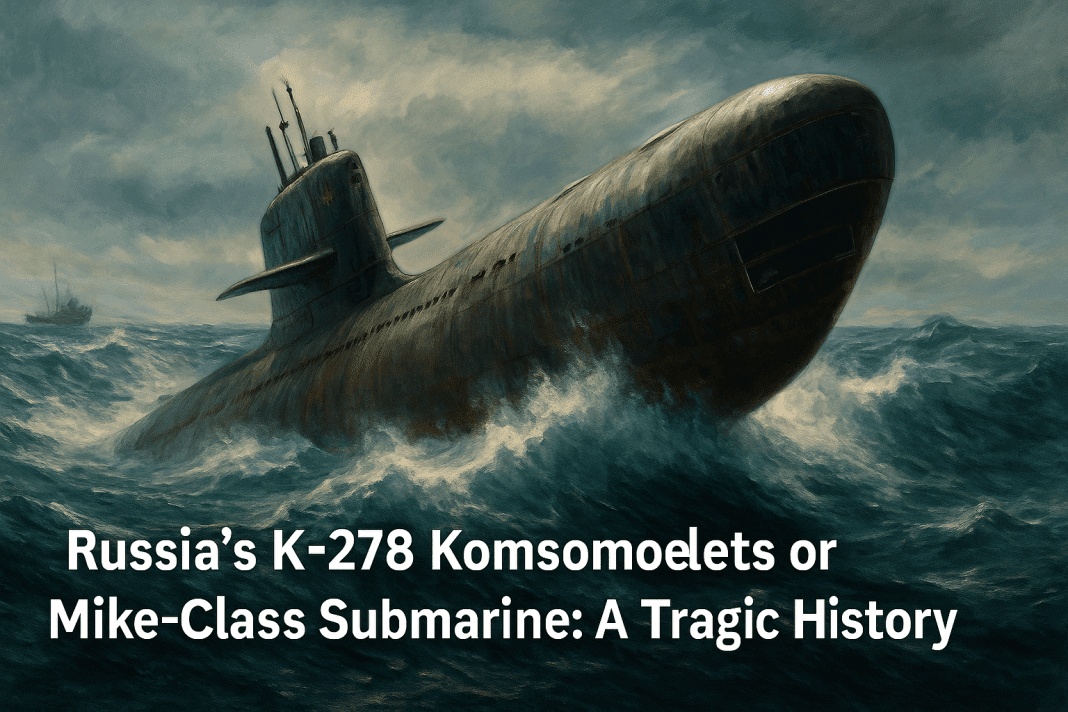Beneath the frigid waters of the Norwegian Sea, around 1.7 kilometers below the surface, lies the wreck of the K-278 Komsomolets—a nuclear-powered Soviet submarine that met a catastrophic end on April 7, 1989. Known to NATO as the “Mike-class”, this vessel was designed for unmatched deep-sea capability and firepower.
K-278 Komsomolets: A Record-Breaking Submarine with Hidden Dangers
The Komsomolets was the only submarine of its kind, built under the Soviet Union’s secret Project 685 Plavnik. It had a strong yet lightweight titanium hull, enabling it to dive deeper than any other military submarine. Its test depth exceeded 1,000 meters, while American torpedoes at the time could only reach about 800 meters. This made the submarine nearly unreachable by enemy weapons.
Armed with six torpedo tubes, the submarine could launch a variety of weapons, including the high-speed VA-111 Shkval. Two of these torpedoes were loaded with nuclear warheads, adding to its strategic value. Despite its power, it carried a relatively small crew of about 64 sailors thanks to high levels of automation—an unusual design that saved space but left fewer people to respond in emergencies.
Russia’s 5th Yasen-M Submarine Armed with Hypersonic Missiles Sparks Tensions
Construction of the Komsomolets began in 1978, and it entered service in 1983. In 1984, it set a world record by diving to 1,020 meters, a depth unmatched by other submarines at the time. Although intended as an experimental vessel, it was deployed for a real patrol mission in 1989, which proved to be a fatal decision.
The K-278 Disaster: April 7, 1989
The Komsomolets was on a routine patrol in the Arctic when tragedy struck. At 11:00 AM, a fire broke out in the seventh compartment—the rearmost part of the submarine. It was likely caused by a short circuit that ignited leaking hydraulic fluid. Within minutes, the fire spread uncontrollably.
Key systems failed one by one. The main power bus shut down, the nuclear reactor automatically scrammed, and smoke filled the interior. The heat became extreme, likely reaching over 800°C, melting parts of the submarine’s internal structure.
The captain ordered an emergency surfacing at 11:15 AM, and the submarine reached the surface. However, the fire kept burning. Compressed air lines feeding into the fire turned the rear compartment into a furnace. The toxic smoke infiltrated other compartments, and even the emergency breathing systems failed due to contamination.
At around 2:00 PM, the fire began to die down, but this brought another danger—seawater started leaking into the damaged compartments. The pressure difference between the outside and inside made the flooding worse. With no power to run the pumps and serious hull damage, the submarine began to list and lose buoyancy.
By 4:42 PM, the captain gave the order to abandon ship. Just minutes later, the submarine’s final log entry was made. At 5:08 PM, the Komsomolets sank stern-first at an 80-degree angle into the deep Barents Sea.
The tragedy didn’t end with the sinking. Though most crew members escaped, they were stranded in freezing waters. A rescue ship arrived over an hour later, but 42 of the 69 crew died, mainly from hypothermia.
The escape capsule also failed. It likely detached only on impact with the seabed. When it resurfaced, the hatch blew open due to pressure change—killing one, drowning three, and leaving only one survivor.
A Sunken Nuclear Threat: K-278’s Legacy and Ongoing Monitoring
The Komsomolets sank with its nuclear reactor and two nuclear warheads still onboard. This raised serious concerns among international environmental agencies, especially in Norway, which shares waters with the Barents Sea.
Just two months after the disaster, the Soviet Union located the wreck using deep-sea submersibles. Starting in the 1990s, Russia and Norway jointly conducted several missions to study the submarine’s condition and potential radiation leaks.
In 2019, a Norwegian-Russian expedition using the Ægir 6000 ROV provided the clearest picture to date. The stern section of the submarine remained intact, but the bow showed major damage, including a 20-square-meter hole above the torpedo compartment. This likely came from an explosion during the sinking.
The reactor was found to be leaking radioactive materials like Cesium-137 and Strontium-90, sometimes at levels hundreds of thousands of times above background levels. These materials escape in bursts or “puffs” from openings in the wreck, such as ventilation pipes.
Russian Submarine’s Passage Sparks Concern in the Philippines
Fortunately, the ocean quickly dilutes the radioactive material due to the wreck’s location—1,680 meters deep. Scientists have sampled water just a few meters from the submarine and found significantly lower radiation levels. So far, they have not found any serious contamination in marine life or fishing areas.
The nuclear warheads in the torpedoes, surprisingly, have not shown signs of leaking. During earlier missions, Russian teams placed titanium plugs and protective plates over the torpedo compartments. These seem to be holding, although they are not perfect seals.
Even now, Russia and Norway continue to monitor the Komsomolets wreck. While it is not an immediate threat, it remains the largest single radioactive source in the Norwegian Sea. The site has become an important case study in understanding how nuclear materials behave in deep ocean conditions.
